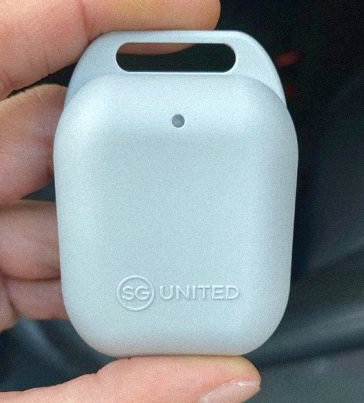Singapore has developed a physical token to enable elderly and vulnerable people to easily be contact traced without the need of having the TraceTogether app.

The device also overcomes some of the issues that are being faced with the mobile app, including battery drainage and issues when the app is running in the background or when the phone is locked. The token runs off a small cell battery and has an estimated battery life of 6-9 months.
How the token works
Each token is given a randomised ID which is linked to a personal identifier such as a telephone number on the contact tracing server. Every 5 minutes, the token scans for any nearby tokens or TraceTogether app users through Bluetooth. If a nearby user is detected, the token exchanges its identification key with the other user’s. The token saves the signal strength, timestamp and the other user’s randomised ID on the storage of the token for 25 days. If a user tests positive to COVID-19, contact tracers are able to collect the token and extract the data using a specific key in order to access and decrypt the data on the token. The contact tracing teams can then identify those who have been close contacts based on the timestamp and signal strength data. The contact tracers are then able to decode the randomised ID of the close contacts in order to contact those who have been in close contact.
Benefits
The token developed by the Singaporean Government has a number of benefits over a mobile app, as the distance between users can be easily calculated based on Bluetooth signal strength, unlike phones which have different Bluetooth transceivers for different models. Also, the issues of battery drainage and the app being inactive whilst the phone is unlocked are averted with a token. A flashing green light on the token alerts the user as to whether the token is active. As the token only uses short-range Bluetooth connections, scanning once every 5 minutes, it is able to have an impressive battery life of up to 9 months.

The token addresses the primary issue that the elderly who are most at risk from COVID-19 are able to be contact traced in the event of an outbreak and that this age group is the least likely to install the tracing app, hence a simple token is a more effective way of enabling contact tracing.
Whilst the token can’t guarantee that all potential contacts can be found, as COVID-19 can spread via surfaces or quickly between two people by droplets, it is able to find close contacts far more accurately than through the app. With accurate distance and timestamp data, contact tracers can be better informed about the interactions between an infected person and other individuals which drastically reduces the rate of transmission in an outbreak.
Privacy
In order to alleviate public concerns over privacy, the Singaporean Government hosted a public “tear-it-down” session in which tech experts found that the device could not do anything beyond its stated purpose, especially given the fact that GPS receivers or WiFi transceivers would cause the cell battery to drain within a matter of hours. The token’s randomised ID changes every 15 minutes, meaning that malicious actors are unable to follow an individual’s movements, just like in the BlueTrace protocol.
The token is definitely an impressive bit of technology given the fact that it is able to communicate via Bluetooth handshakes with changing temporary IDs, have an internal clock for timestamps and save interactions on its flash memory every 5 minutes whilst having a battery life of up to 9 months. Singapore is currently trialling the token with 10,000 seniors. If successful, this could drastically improve the accuracy of electronic contact tracing and pave the way for other jurisdictions to re-open whilst having confidence in the contact tracing systems to control any potential outbreak.
Sources: